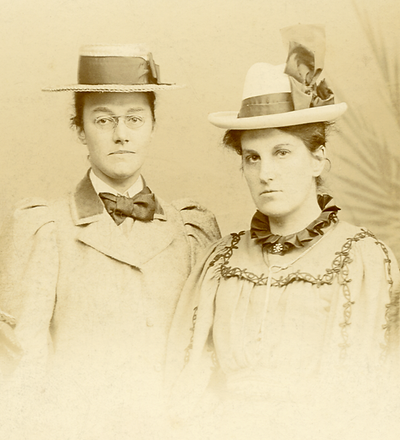
Margaret and Lilian
It was in her late twenties that Margaret first met Lilian Harris, who was to become her life companion. Their backgrounds were very different. Margaret had grown up in a progressive atmosphere, with parents who ensured she had a good education and supported her in her work. Contrastingly, Lilian, the daughter of a wealthy banker, was initially stifled by conventional expectations of young women of her class. Although highly intelligent she had received scant education, and Margaret remembered first encountering her ‘sitting at home ... trying to occupy herself with carving and embroidery’.
This was in 1889, soon after Margaret had been elected as General Secretary of the Women’s Co-operative Guild. Her father had recently been obliged to give up his London parish for a post in the small Westmorland town of Kirkby Lonsdale, taking the family with him, including Margaret. It was here that she came across Lilian.

New to running the Guild, and wrenched away from her work and social life in London, Margaret needed help. For her part, Lilian needed an outlet. She started helping Margaret in the Guild office, set up in the Kirkby Lonsdale vicarage. But when the pair went on a trip to London in connection with the Guild, Lilian became briefly, though seriously, ill. Her parents were furious. Margaret’s mother relayed their description of their daughter, now in her mid-twenties, as ‘a naughty girl … entirely incompetent to take care of herself’. Mr Harris told Lilian to give up the Guild work, insisting that ‘nothing can prosper that is done against a parent’s wish’.
Lilian showed her mettle, however. Despite parental opposition, she somehow continued to work alongside Margaret, and rapidly became indispensable as the Guild’s expanding membership produced an ever larger mountain of work. When her parents moved away some years later she stayed on in Kirkby Lonsdale, only leaving for London when Margaret herself returned there in 1908.
Quietly efficient, calm and helpful, Lilian was recognised within the Guild as a brilliant administrator and was officially designated Guild Assistant Secretary from 1901. She inspired respect and also affection from Guild activists, who often relied on her for advice and help on organisational problems. More, her unassuming exterior masked her considerable intellectual abilities: she was a talented researcher and writer and produced a number of pamphlets in her later years.
As time passed, Lilian and Margaret proved themselves a perfect combination for the Guild. The two women shared their ideals and political beliefs; Margaret Bondfield (later Britain’s first female Cabinet Minister), who worked with them in the 1910s, described Margaret as ‘our inspiration and driving force’, while Lilian was ‘the practical mind which kept us in the realms of the possible’. When they retired together, the Guild honoured them together. This was a true partnership.
Although she was quiet and retiring compared with Margaret, Lilian too was a strong character. She adopted the ‘New Woman’ style of the 1890s, intriguing the young girls at a Guild project in Sunderland who had never seen anything like it: ‘She wears bloomers and no petticoats at all!’ Lilian also rode a bike, as did other emancipated young women, and later smoked a pipe – the latter rather more unusual. She shared Margaret’s radical politics and like her stood against the current in World War One, coming out as a pacifist.
After Margaret’s father died in 1916, she and Lilian lived together for nearly thirty years. While the two women retained some independence from one another, each having their own bedroom and sitting room, they were increasingly seen as a couple; and during their last years supported one another devotedly through the trials of illness and old age.

Age and disability could not quench Lilian’s lively interest in the world, especially in politics. She survived Margaret by six years, and Margaret’s niece remembered visiting her during that time: ‘… she was blind and very deaf, but far more intelligent than everybody else.’
Although Lilian was not a public figure like Margaret, she was remarkable in her own way; as their friend Arthur Ponsonby commented, she was an example of ‘the wonderful influence of a completely obscure person’.
